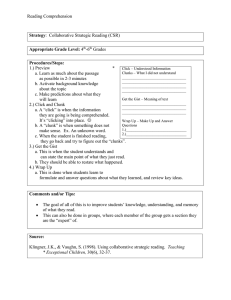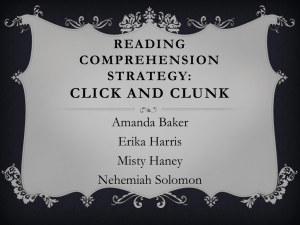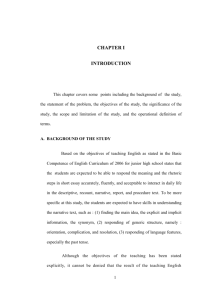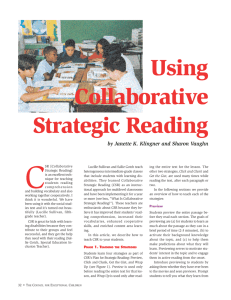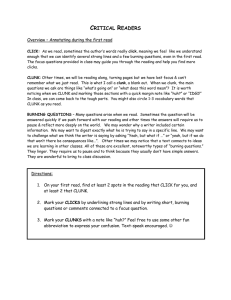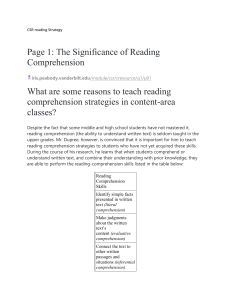collsr
advertisement
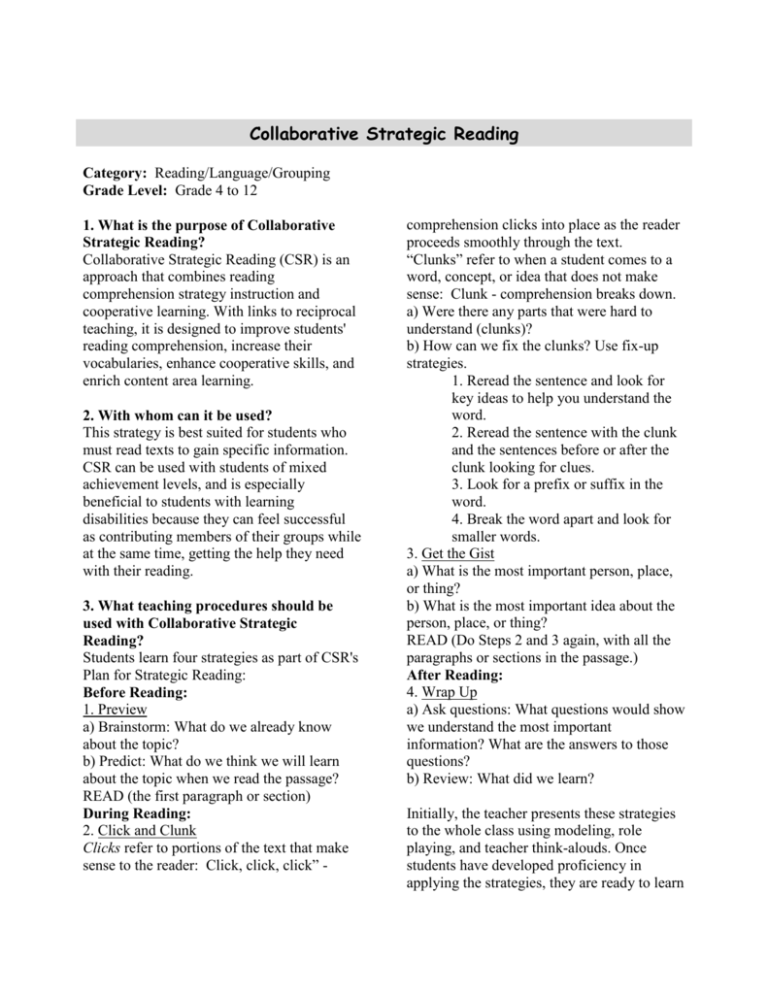
Collaborative Strategic Reading Category: Reading/Language/Grouping Grade Level: Grade 4 to 12 1. What is the purpose of Collaborative Strategic Reading? Collaborative Strategic Reading (CSR) is an approach that combines reading comprehension strategy instruction and cooperative learning. With links to reciprocal teaching, it is designed to improve students' reading comprehension, increase their vocabularies, enhance cooperative skills, and enrich content area learning. 2. With whom can it be used? This strategy is best suited for students who must read texts to gain specific information. CSR can be used with students of mixed achievement levels, and is especially beneficial to students with learning disabilities because they can feel successful as contributing members of their groups while at the same time, getting the help they need with their reading. 3. What teaching procedures should be used with Collaborative Strategic Reading? Students learn four strategies as part of CSR's Plan for Strategic Reading: Before Reading: 1. Preview a) Brainstorm: What do we already know about the topic? b) Predict: What do we think we will learn about the topic when we read the passage? READ (the first paragraph or section) During Reading: 2. Click and Clunk Clicks refer to portions of the text that make sense to the reader: Click, click, click” - comprehension clicks into place as the reader proceeds smoothly through the text. “Clunks” refer to when a student comes to a word, concept, or idea that does not make sense: Clunk - comprehension breaks down. a) Were there any parts that were hard to understand (clunks)? b) How can we fix the clunks? Use fix-up strategies. 1. Reread the sentence and look for key ideas to help you understand the word. 2. Reread the sentence with the clunk and the sentences before or after the clunk looking for clues. 3. Look for a prefix or suffix in the word. 4. Break the word apart and look for smaller words. 3. Get the Gist a) What is the most important person, place, or thing? b) What is the most important idea about the person, place, or thing? READ (Do Steps 2 and 3 again, with all the paragraphs or sections in the passage.) After Reading: 4. Wrap Up a) Ask questions: What questions would show we understand the most important information? What are the answers to those questions? b) Review: What did we learn? Initially, the teacher presents these strategies to the whole class using modeling, role playing, and teacher think-alouds. Once students have developed proficiency in applying the strategies, they are ready to learn the roles they will perform while using CSR in cooperative learning groups. Possible roles include: Leader (explains what to read and what strategy to apply), Clunk Expert (reminds the group of the fix-up strategies that can be used), Announcer (calls on different group members to read or share an idea), Encourager (gives feedback, looks for behaviours to praise), Reporter (reports to the class the main ideas the group has learned) and Time Keeper (lets the group know when it is time to move from one portion of CSR to the next). 4. In what types of settings should Collaborative Strategic Reading be used? Because CSR can be used with students of mixed achievement levels (who work in small groups of five students each), it is a good whole-class instructional approach in classrooms that include students with learning disabilities. The teacher circulates among the groups and provides ongoing assistance. CSR can also be used with small groups in Special Education settings. 5. To what extent has research shown Collaborative Strategic Reading to be useful? Research indicates that Collaborative Strategic Reading does, indeed, result in student improvement in its four goal areas: reading comprehension, vocabulary, cooperative skills, and content area learning. Specifically, students have been found to implement the clarification (Click and Chunk) and main idea (Get the Gist) strategies most consistently and effectively. While it was developed to enhance reading comprehension skills for students with learning disabilities and students with reading difficulties, CSR has also yielded positive outcomes with average and above-average students in general education settings. References 1. Klingner, J.K., & Vaughn, S. (1996). Reciprocal teaching of reading comprehension strategies for students with learning disabilities who use English as a second language. Elementary School Journal, 96, 275-293. 2. Klingner, J.K. & Vaughn, S. (1998). Using collaborative strategic reading. Teaching Exceptional Children, 30, 3237. 3. Klingner, J.K., Vaughn, S., & Schumm, J.S. (1998). Collaborative strategic reading during social studies in heterogeneous fourth-grade classrooms. Elementary School Journal, 99, 3-22. 4. Palincsar, A.S., & Brown, A.L. (1984). The reciprocal teaching of comprehension-fostering and comprehension-monitoring activities. Cognition and Instruction, 1,117-175. 5. Stevens, R.J., Slavin, R.E., & Farnish, A.M. (1991). The effects of cooperative learning and direct instruction in reading comprehension strategies on main idea identification. Journal of Educational Psychology. 83, 8-16. Reviewed by: Lesley Daniels
